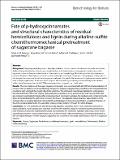Por favor, use este identificador para citar o enlazar a este item:
http://hdl.handle.net/10261/165746COMPARTIR / EXPORTAR:
 SHARE SHARE
 CORE
BASE CORE
BASE
|
|
| Visualizar otros formatos: MARC | Dublin Core | RDF | ORE | MODS | METS | DIDL | DATACITE | |

| Título: | Fate of p-hydroxycinnamates and structural characteristics of residual hemicelluloses and lignin during alkaline-sulfite chemithermomechanical pretreatment of sugarcane bagasse |
Autor: | Reinoso, Felipe A. M.; Rencoret, Jorge CSIC ORCID; Gutiérrez Suárez, Ana CSIC ORCID ; Milagres, Adriane M. F.; Río Andrade, José Carlos del CSIC ORCID ; Ferraz, André | Palabras clave: | Grasses Sugarcane Recalcitrance p-Hydroxycinnamates Lignin Hemicelluloses Pretreatment Alkalinesulfite Biorefinery |
Fecha de publicación: | dic-2018 | Editor: | BioMed Central | Citación: | Biotechnology for Biofuels 11: 153 (12018) | Resumen: | Background: Preparing multiple products from lignocellulosic biomass feedstock enhances the profit and sustainability of future biorefineries. Grasses are suitable feedstocks for biorefineries as they permit a variety of possible by-products due to their particular chemical characteristics and morphology. Elucidating the fate of p-hydroxycinnamates (ferulates—FAs and p-coumarates—pCAs) and major structural components during bioprocessing helps to discriminate the sources of recalcitrance in grasses and paves the way for the recovery of p-hydroxycinnamates, which have multiple applications. To address these subjects, we assessed sugarcane bagasse biorefining under alkalinesulfite chemithermomechanical (AS-CTM) pretreatment and enzymatic saccharification. Results: The mass balances of the major bagasse components were combined with 2D-NMR structural evaluation of process solids to advance our understanding of sugarcane bagasse changes during biorefining. AS-CTM pretreatment provided a high yield and thoroughly digestible substrates. The pretreated material was depleted in acetyl groups, but retained 62 and 79% of the original lignin and xylan, respectively. Forty percent of the total FAs and pCAs were also retained in pretreated material. After pretreatment and enzymatic hydrolysis, the residual solids contained mostly lignin and ester-linked pCAs, with minor amounts of FAs and non-digested polysaccharides. Saponification of the residual solids, at a higher alkali load, cleaved all the ester linkages in the pCAs; nevertheless, a significant fraction of the pCAs remained attached to the saponified solids, probably to lignin, through 4-O ether-linkages. Conclusion: AS-CTM pretreatment provided soundly digestible substrates, which retain substantial amounts of xylans and lignin. Acetyl groups were depleted, but 40% of the total FAs and pCAs remained in pretreated material. Ester-linked pCAs detected in pretreated material also resisted to the enzymatic hydrolysis step. Only a more severe saponification reaction cleaved ester linkages of pCAs from residual solids; nevertheless, pCAs remained attached to the core lignin through 4-O ether-linkages, suggesting the occurrence of an alkali-stable fraction of pCAs in sugarcane bagasse. | Descripción: | 12 páginas.-- 2 figuras.-- 4 tablas.-- 39 referencias.-- The online version of this article ( https://doi.org/10.1186/s13068-018-1155-3) contains supplementary material, which is available to authorized users. | Versión del editor: | http://dx.doi.org/10.1186/s13068-018-1155-3 | URI: | http://hdl.handle.net/10261/165746 | DOI: | 10.1186/s13068-018-1155-3 | ISSN: | 1754-6834 |
| Aparece en las colecciones: | (IRNAS) Artículos |
Ficheros en este ítem:
| Fichero | Descripción | Tamaño | Formato | |
|---|---|---|---|---|
| Fate_P_hydroxycinnamates_2018_OA_CC.pdf | 2,59 MB | Adobe PDF |  Visualizar/Abrir |
CORE Recommender
PubMed Central
Citations
6
checked on 24-abr-2024
SCOPUSTM
Citations
28
checked on 19-abr-2024
WEB OF SCIENCETM
Citations
26
checked on 28-feb-2024
Page view(s)
326
checked on 22-abr-2024
Download(s)
246
checked on 22-abr-2024

